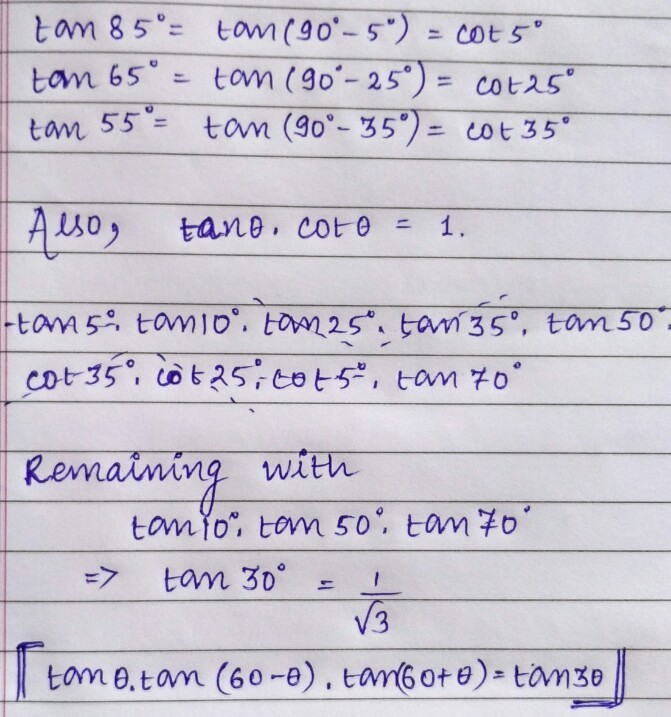Random Assortment of tan x
tan 5 ∘ tan 1 0 ∘ tan 2 5 ∘ tan 3 5 ∘ tan 5 0 ∘ tan 5 5 ∘ tan 6 5 ∘ tan 7 0 ∘ tan 8 5 ∘ = ?
This section requires Javascript.
You are seeing this because something didn't load right. We suggest you, (a) try
refreshing the page, (b) enabling javascript if it is disabled on your browser and,
finally, (c)
loading the
non-javascript version of this page
. We're sorry about the hassle.
2 solutions

Nice solution. I made it more complicated than necessary by using the identity tan ( x ) tan ( 6 0 − x ) tan ( 6 0 + x ) = tan ( 3 x ) , (in degree measure), on three sets of three terms, namely
tan ( 5 ) tan ( 5 5 ) tan ( 6 5 ) = tan ( 1 5 ) , tan ( 1 0 ) tan ( 5 0 ) tan ( 7 0 ) = tan ( 3 0 ) and
tan ( 2 5 ) tan ( 3 5 ) tan ( 8 5 ) = tan ( 7 5 ) .
The resulting product is then tan ( 3 0 ) tan ( 1 5 ) tan ( 7 5 ) = tan ( 3 0 ) ,
since tan ( 1 5 ) tan ( 7 5 ) = tan ( 1 5 ) cot ( 1 5 ) = 1 .
Log in to reply
tan ( 2 5 ) tan ( 3 5 ) tan ( 8 0 ) = tan ( 7 5 )
? ? ? 8 5 ? ? ? ⌣ ¨
Because in the last line, tan ( θ ) × tan ( 2 π − θ ) = 1
Log in to reply
Edit made; thanks for catching that typo. :)
"tan(30)tan(15)tan(75)" how the product of this term is equal to "tan(30)"? its not following the tan(x)tan(60-x)tan(60+x)=tan(3x) formula.
Log in to reply
Realize that, tan ( θ ) × tan ( 2 π − θ ) = 1
because tan(75)=cot(15) and tan(15)xcot(15) = 1
